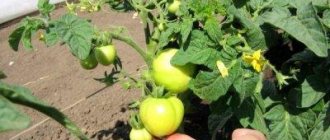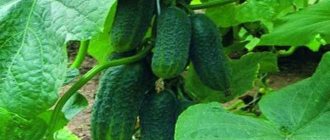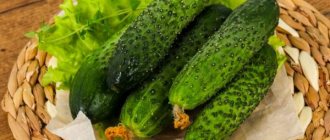All summer residents, without exception, grow tomatoes on their country plots. There are many varieties of these plants. Moreover, one of the most unusual is the Octopus F1, or tomato tree. Caring for tomatoes of this variety is easy. However, they are still grown using a slightly different technology than ordinary tomatoes. Further in the article, we will look in detail at what the unusual Octopus F1 tomato actually is - photos, reviews from gardeners, and care features will be presented in our review.
General description of the variety
The Octopus F1 tomato is called a tree because it is grown over two seasons and reaches a very large size. The trunk of such a perennial tomato becomes woody, and the shoots form a spreading crown, the area of which can reach 40-50 m2. From one such tree alone you can collect up to 1500 kg of fruit. This variety has no restrictions in growth. At the same time, it constantly produces new shoots. Therefore, when growing it in a greenhouse, a special frame is built.
The fruits of such a plant as the Octopus F1 tomato tree, reviews of which are also good for this reason, are simply distinguished by excellent taste characteristics. This variety is also praised for the fact that its fruits have an even, close to round shape and are not too large in size. One bunch can contain up to 6-7 tomatoes. The color of the fruits of this tomato is red. The brushes themselves grow every 3-4 leaves.
Another reason for the extraordinary popularity of this variety and good reviews about it is that its fruits are characterized by increased shelf life. Some summer residents manage to store Octopus F1 tomatoes until the New Year.
Positive and negative qualities
Cream f1 is a capricious plant, so its description includes both advantages and disadvantages. Among the advantages are noted:
- High yield. If 3-4 trees are planted on a plot, the gardener can get up to 80 kg of tomatoes.
- Long-term fruiting (from 2 to 4 months).
- Early fruit ripening.
- Good immunity to diseases and parasites.
The hybrid feels most comfortable in greenhouses or greenhouses. It is possible to grow it outdoors, but achieving the same yields is extremely difficult. In addition, the hybrid does not tolerate cold, as a result it is planted outside only in southern regions with mild winters.
Seeds of annual hybrid forms of tomatoes Sprut Slivka are available for free sale, but growing them at home has many nuances that are impossible to accomplish.
Features of care
How is this original tomato, Octopus F1, grown? Photos and reviews from summer residents and gardeners allow us to judge it as a truly very original and at the same time productive plant. However, you can, of course, get a lot of tomatoes from this variety only with proper care. In addition to the unusual appearance and size, Octopus F1 tomatoes differ from other varieties in their cultivation technology. They are planted exclusively in large greenhouses, which must be heated. After all, as already mentioned, one bush can be grown for two seasons. In the warm season, the optimal temperature for these tomatoes is considered to be 24-26 degrees, in winter - at least 19 degrees.
Many gardeners grow these tomatoes simply in open ground or an unheated greenhouse - for one season. In this case, the tree, of course, does not grow. But even when planted outside, tomatoes of this variety reach quite impressive sizes (even larger than De Barao).
When growing Sprut F1 tomatoes in soil, the same fertilizers are used as for conventional varieties. These can be either organic or mineral compounds. But more often these tomatoes are grown using a special technology - hydroponics. This allows you to completely control the process of nutrient consumption by the plant and promotes the delivery of the maximum amount of oxygen to the roots.
Technology of growing seedlings
In order for the Octopus tomato to have a well-developed root system and powerful leaf apparatus in the future and bear fruit abundantly, you need to adhere to certain recommendations. This applies to the timing of sowing and caring for seedlings.
Disembarkation dates
It is necessary to plant Sprut tomato seeds in the ground only those that were purchased at specialized retail outlets. These must be specimens of the first generation hybrid. Seeds are planted in the soil in the second half of January - mid-February; in regions with a warm climate, sowing can be done in open ground.
Seed germination occurs at temperatures from +25 °C; when shoots appear, the indicators are reduced to +20 °C. In addition, you need to take care of additional lighting; the duration of daylight hours should be 10–12 hours.
Seed preparation
In most cases, the seeds of hybrid plants, including the Sprut tomato, do not require preliminary preparation. To be more sure that the seed will not be exposed to various kinds of diseases, it is kept in a weak solution of potassium permanganate for 20 minutes and then washed under running water. Additionally, the seeds can be treated with a growth stimulant.
Expert opinion
Stanislav Pavlovich
Gardener with 17 years of experience and our expert
Ask a Question
Prepared Octopus tomatoes are planted in disinfected containers. They are filled with fertile soil mixture, where garden soil, turf and biofertilizer are taken in equal proportions. To prevent oxygen starvation of the roots in containers, you need to make holes in the walls, and to remove excess moisture, holes in the bottom of the container.
Planting Sprut tomato seeds in the soil is done in shallow grooves, up to 1 cm. A distance of 2–3 cm must be maintained between them. Sprinkle them with a thin layer of soil and carefully compact them. After that, the seeds are moistened with a spray bottle, a greenhouse effect is created using a plastic bag and put away in a warm place.
Picking
After the formation of 2–3 true leaves, the young plants are distributed into separate containers. During the entire seedling period, it is recommended to carry out several transfers of tomatoes, where each time the container is selected higher and wider.
Top dressing
Irrigation of seedlings is carried out 2 times a week with settled water. Along with watering, you can also combine fertilizing. For young plants, vermicompost, complex compositions “Kemiru” or “Agricola” are used. The main thing is to add nutrients regularly, but in compliance with the dosage.
Growing hydroponically
So, we have given a detailed description of such a plant as the Octopus F1 tomato. Reviews about it are simply excellent, especially when using hydroponic growing technology. In this case, professional farmers, and sometimes just summer residents, use special plugs made of a material that absorbs water well. The seeds are planted in them. A week later, each such plug is placed on its side and several pieces are combined on a tray. As a result, the tomato stems bend and become stronger. The cubes themselves are thoroughly soaked in water.
The seedlings are transferred to special containers filled with perlite and connected to drainage pipes. When watering, the rock collects a nutrient solution, the remains of which flow into special tanks. Sprut F1 tomatoes are planted even if they do not want to get trees, at a considerable distance from each other (1-1.5 m).
Sometimes, instead of containers with perlite, special slabs (for example, “Argo”) are used for plants. Nutrient solutions for irrigation are prepared according to special recipe tables. In this case, a variety of fertilizers and microelements are used. When growing a tree, these tomatoes are not allowed to bear fruit for the first 7-8 months. At this time, the plants’ root system and crown itself are actively forming.
How to grow
It is recommended to grow the hybrid Sprut Slivka using seedlings. The main thing is to provide the tomatoes with enough light and heat and not forget about fertilizers.
Growing in greenhouses
For gardeners living in the middle zone, it is better to grow the Sprut Slivka tomato in a greenhouse, where it can produce fruit all year round. By adhering to special agricultural techniques, you can get up to 1.5 tons of fruits per year. To get a harvest in autumn and winter, seeds must be sown in the second half of August.
Attention. Growing tomatoes on an industrial scale in greenhouses requires special equipment, so it is easier and more convenient for gardeners to plant tomatoes for one season within their household plots.
The most important components in growing tomatoes in a greenhouse are good lighting and drip irrigation to maintain the required level of soil moisture. There should be a lot of light in the greenhouse. Additional lighting should work 14-15 hours a day.
Rules of care:
- 3 weeks after planting the seedlings, the plants are planted in separate containers with a volume of at least 1 liter to ensure healthy growth of the root system.
- At this stage of growth, water the plants sparingly.
- Once every 10 days, be sure to feed the plants with vermicompost.
- From mid-April you can plant seedlings in a greenhouse.
- Before planting, remove two pairs of lower leaves. Place the plants in the ground to a depth of 15 cm.
- A handful of humus and wood ash are added to each planting hole.
- Until the warm season arrives, the plants are covered with non-woven material on arches.
Important. In order for the bush to turn into a tomato tree, remove the ovaries during the first months, preventing it from bearing fruit. After a few months, you will see the yield increase greatly.
Growing in open ground
Only in warm areas is it permissible to grow this hybrid in open ground. Planting is carried out in January or February with purchased seeds, that is, only first-generation hybrids. During a growing season using this method, you can get up to 10 kg of harvest from one plant.
Attention. Self-grown seeds do not retain hybrid characteristics.
During the entire period of plant growth, it is necessary to provide them with heating, maintaining the desired temperature of 20-25 ° C, as well as illumination using a phytolamp.
Maintaining a comfortable temperature is extremely important, since seeds can only sprout under certain conditions.
Important. The rate of seedling maturation decreases significantly at lower temperatures.
Step-by-step instructions for picking seedlings:
- 1 or 2 days before picking, the seedlings are watered abundantly. The sprouts will be less damaged if you lift them by the stem.
- Add superphosphate, vermicompost and potassium sulfate in small quantities to the plant soil. It would not be superfluous to soil with a solution of potassium permanganate (0.5 g per 10 liters of water). Fertilizers are applied right before transplanting seedlings into the ground.
- Transplant the seedlings into small 100-150 ml pots and wait 2-3 weeks until the plants are ready to be transplanted into open ground.
- It is recommended to plant seedlings in open ground at the beginning of summer. The plant should have from 5 to 7 leaves, and its height should be 15-30 cm. Plants are planted at a distance of 1.5 m from each other.
- Before planting, make holes about 20 cm deep.
- Seedlings are planted to a depth of several centimeters lower than in pots. In this case, the lower leaves of the plants should be above the ground.
- To encourage branching, pinch the main root.
After all the steps, all that remains is to water the tomatoes on time, feed them with fertilizers, remove old yellow leaves, and also tie up the plants.
Recommendations for growing tomatoes Octopus F1
The seedlings of these tomatoes should be illuminated in the evening. If you plan to grow tomatoes using conventional technology, in the ground, the seeds are planted not in boxes, but in larger containers. Many gardeners sow them in plastic bags filled with soil mixture (several pieces). When transferring seedlings into the ground, the main root of tomatoes of this variety must be cut off. This promotes rapid development of the root system. Trellis are also a must when growing these plants. After all, large size is what distinguishes the Octopus F1 tomato. Reviews (photos presented on the page clearly show the size of the bushes) about these tomatoes are good mainly from those gardeners who did not violate any recommendations or technologies in the process of growing them.
For example, Octopus tomatoes should never be pinched. An attempt to artificially form the crown of tomatoes of this variety can lead to a significant reduction in yield. The gardener only needs to ensure that no yellowed leaves remain on the bushes or trees. When growing in soil, fertilizing is applied at the root.
Pest and disease control
Late blight is a fungal disease that poses a serious danger to nightshade crops. The disease affects individual bushes and rapidly spreads to neighboring ones. Favorable conditions for the development of the disease are: low temperature and high humidity. It is necessary to promptly get rid of the affected leaves and spray the bushes with special means (Quadris, Ridomil, Bordeaux mixture, Ecosil, Fitosporin and other fungicides).
To minimize the risk of root or crown rot, it is necessary to periodically loosen and mulch the soil, as well as provide the bushes with regular watering and ventilate the greenhouse (when grown in closed ground conditions). The main enemies of tomatoes are spider mites, thrips and aphids. The best prevention is spraying with a manganese solution. In case of severe damage, industrial insecticides are used. Treatment is carried out two to three times, maintaining an interval of several days.
Late blight appears as a fluffy white coating on stems and leaves and dark spots on fruits
Types of tomatoes Octopus F1
Tomato Octopus F1 (photos, reviews from gardeners allow us to judge it as one of the most productive and unpretentious varieties), thus, can be grown as a “tree” for two seasons. In addition to its main variety (F1 itself), there are also F1 Slivka tomatoes. This variety is also positioned by breeders as a tomato tree.
The tomato Sprut Slivka F1, which also has good reviews, differs from the main variety of tomatoes primarily in the shape of the fruit. The tomatoes of this variety are not round, but oval, but also have a red color. At the same time, they have dense and quite juicy and tender flesh. This variety is named cream precisely for the slightly oblong shape of the fruit. They, like the tomatoes of the main variety, are not too large in size and are collected in clusters of 6-7 pieces.
The excellent taste of the fruit is also what earned this Octopus F1 tomato good reviews. In open ground or an unheated greenhouse, these tomatoes can reach a height of more than 1.5 meters (up to 2.2 m). The fruits of tomatoes Sprut F1 Cream ripen on the 101-110th day after planting. Just like the fruits of the main variety, Slivka can be stored for a very long time. Even under normal conditions, ripe tomatoes do not rot for almost 1.5 months.
Secrets of getting good results
In order for the Octopus f1 tomato tree to gain strength and produce a harvest in the garden plot, it needs to be properly cared for. Growing rules must be followed. The ideal location is a warm, spacious greenhouse. In such conditions, the tree grows tall and bears fruit for several seasons.
See also
Description of the North Queen tomato variety, features of cultivation and careRead
How to grow a tomato in a greenhouse environment? Conditions required to obtain a tomato tree Octopus f1:
- The greenhouse should be large and well heated.
- Since tree growth lasts about 1.5 years, the greenhouse must be heated all year round.
- During the first months, the stem is formed, so there is no need to wait for a harvest.
- In order for the crown to cling to something, a metal or wooden structure is constructed.
- Watering the f1 Sprut variety should be regular.
- It is recommended to spray the bushes with special preparations against diseases.
- To grow a healthy bush, it is necessary to feed it with mineral fertilizers.
Seedlings begin to be transplanted into the greenhouse in early February. The temperature in the greenhouse should be about 22 degrees, there must be enough light. When the seedlings grow a little, it is necessary to dive. Important nuances of growing Octopus in a greenhouse:
- You should not use seeds collected from bushes for planting.
- Sowing should begin at the end of January (in order for the seeds to germinate faster, they need to be germinated by placing them in a napkin soaked in water).
- The sprouted sprouts are transplanted into a prepared container filled with soil.
- After the seedlings exceed 25 cm, further care continues in the greenhouse.
- The distance between the bushes should be large (about 1.5 meters).
- The crown needs to be provided with strong support.
- Requires abundant, regular watering.
- It is necessary to use fertilizers for feeding.
- The soil should be loosened from time to time.
To grow tomato Octopus f1 in open ground, you need to prepare seedlings. For seedlings, seeds from the store will be useful. If you collect the seeds, the subsequent harvest will be of poor quality.
The technology of planting in open ground involves observing important cultivation points to obtain a high-quality harvest. Features of moving seedlings into open ground:
- Before planting, the soil is loosened and fertilized (soil with a mixture of clay and sand is best suited).
- For cultivation, select a plot of land that is well lit.
- The sprout is placed in holes about 20 cm deep, it must be protected from the wind and receive enough light.
- The root is pinched, thereby increasing branching.
- Once a month it is necessary to feed the plant with mineral fertilizers.
- As soon as one cluster of fruits ripens, all leaves must be removed from it.
- It is recommended to water the plant with iodine solution at least three times per season (one bottle of iodine is diluted in 10 liters of water and watered at the base of the plant).
See also
Description of the tomato variety Sugar pink, features of cultivation and careRead
It is best to move seedlings into open ground in early June, when Sprut tomatoes will have a stem larger than 20 cm in size and several leaves on it.
Octopus tomatoes can be propagated using the vegetative method. A cutting is taken from a healthy bush and planted in the soil of the greenhouse. If the cutting was taken in winter, then it is planted in a pot and cared for temporarily at home. At the beginning of spring, they are transplanted into the ground and continue to be cared for.
Harvesting begins when the fruits just begin to turn red. Then they are placed in a well-lit place where the tomatoes will ripen for another two weeks. For further storage of grown tomatoes, they need to be moved to a warm, dry room.
Advantages of Octopus F1 tomatoes
In addition to tasty fruits and intensive development, the advantages of this variety include:
- Good branching.
- Fruiting from July to September.
- Uniform distribution of fruits according to taste. Tomatoes collected at the top of the bush are no different from tomatoes picked at the bottom.
- Adaptability to high humidity, cold and heat.
How to grow on a balcony
A small tomato tree can also be grown on the balcony. The hybrid can be planted year-round, but it is better in the spring.
How to plant on the balcony:
- The seeds are buried 1.5 cm;
- Water, cover;
- Place the sprouts in separate containers;
- Place containers with seedlings on an insulated loggia or southern windowsill;
- Moss, expanded clay, and sawdust are used as mulch;
- As soon as the seedlings grow up, transplant them into a shallow, wide pot;
- Water with fertilizing through a tray once every two weeks;
- In winter, reduce the number of waterings and do not apply fertilizers.
Tomatoes Octopus F1: reviews from gardeners
As already mentioned, gardeners have a wonderful opinion about these tomatoes. Of course, only rare exotic lovers grow tomato trees on their plots. Basically, gardeners plant tomatoes of this variety in ordinary unheated greenhouses or in open ground. At the same time, many gardeners believe that in this case, you can get an excellent harvest from the bushes. One plant usually ripens up to 10 kg of fruit per season. This variety is popular among owners of summer cottages in almost all regions of our country.
In addition to productivity and relative ease of care, the good tomato variety Sprut F1 has earned reviews from gardeners for its resistance to disease. For example, these tomatoes are practically not afraid of aphids and cicadas. In addition, the variety is resistant to such common tomato diseases as tobacco mosaic and verticillium wilt.
Prevention of diseases and pests
Hybrid Octopus Slivka is resistant to diseases and pests, but insects can cause concern to farmers. Since they easily spread infections by moving from one fruit to another, it is important to take care of prevention.
Important. Plant dill next to the tomatoes. Its smell will repel insects.
Dangerous diseases and pests:
- One of the most serious pests is aphids. To get rid of it, spray the leaves of the bushes with cold water. You can add laundry soap to the water.
- Rotting of plants is considered a serious threat to the crop. This process is caused by wet weather and failure to comply with the correct watering regime. As a result, brown spots form on the stem, which subsequently spread to the leaves and fruits.
- A dangerous and common disease of tomatoes is late blight. This fungal infection most often destroys tomatoes. If you notice dark brown spots on the stems and leaves, then this is late blight. To avoid it, plant tomatoes away from potatoes, choose a well-ventilated and sunny place, and follow the watering regime.
What pests can affect
Sprut F1 tomatoes are practically insensitive to diseases. However, sometimes bacteria, fungi or common insect pests can still attack these plants. Like most other tomatoes, this variety is afraid of infections such as root, white and gray rot, mosaic, late blight, fomoz, etc. Therefore, when growing the Sprut F1 tomato, a number of preventive measures should be taken to prevent infection. In addition to fungi and bacteria, insects such as spider mites, cutworms or whiteflies can cause damage to them.
Transplantation into open ground
In order for Sprut tomato seedlings to quickly adapt to new conditions and grow, you need to know how and when to place them in a permanent place.
Site selection and preparation
Octopus grows and develops best in a well-lit area of the garden, where there are no drafts. The soil for it should be light, loose and fertile. For these purposes, it is effective to use mature humus or compost, which is applied in advance - in the fall, to a depth of 25 cm.
Planting scheme
According to the observations of those who planted the Octopus tomato, the distance between seedlings should be 150 cm. The seedlings are transferred to a permanent place when their height reaches 15–30 cm and there are 5–7 leaves. Before planting in holes, the roots of plants should be treated with iodine, where 1 bottle of pharmaceutical product is used per 10 liters of water. The depth of planting tomatoes is 20 cm.
Using a barrel without a bottom
The Octopus hybrid is also grown in a barrel without a bottom. Place it there when the length of the stem is 1 m. It is necessary to place compost and fertile soil in layers in a large container. To prepare the organic component, you need to take rotted tree leaves, plant stems, bird droppings, peat, and manure.
See also: Nuances of growing and characteristics of the French bunch tomato
Tomatoes Octopus F1 - an excellent choice for a summer cottage
Well, we hope now you more or less understand what the Octopus F1 tomato is. Photos, reviews discussed in the article - all this serves as unconditional proof of its unusualness and high yield. Sprut F1 tomatoes have earned their popularity among summer cottage owners for good reason. The variety is not only productive, but also very powerful and hardy. At the same time, it has unusually tasty and shelf-stable fruits. However, in any case, it is, of course, possible to grow a tomato tree or even just a few dozen healthy bushes on your plot only by strictly following all the required plant care technologies.
Tomatoes 'Octopus'. Difference from other tomatoes and growing methods
For some time now, the Sprut tomato variety has become a real find for those gardeners who are accustomed to bold experiments. It must be said that this hybrid has an unusual size and appearance, and it grows quite quickly. Usually people call Octopus tomatoes not tomatoes, but tomato tree. And the reason for this is obvious, because if this tomato is grown for at least one and a half years, then a truly “tomato” tree can grow. Although those gardeners who grew this variety of tomatoes for only one season were able to achieve success.
At its genetic level, the Sprut tomato variety differs from other similar varieties in its well-developed root system and powerful leaves. The fruits of this variety can be harvested from July to September, which is already nonsense for harvesting tomatoes. And the fruits are truly heroic, because the weight of one such tomato is 250 g. Moreover, they can be stored for quite a long time - right up to mid-winter. The high fertility of this variety is also due to the fact that it is very resistant to various diseases that often affect tomatoes. Such diseases especially peak in hot and dry years.
Bushes of this variety can reach a height of 2.5-3 meters, and the crown of such a plant grows so much that it can take over all 0.5 acres of the garden. The lifespan of such a tomato tree is at least 2 years, therefore, in the temperate climate of our country, “Sprut” tomatoes are best grown not in open ground, but in greenhouse conditions.
At the same time, the optimal way to grow such tomatoes is the so-called hydroponic method, in which the root system of the tomato tree receives a sufficient amount of oxygen. As a result, the plant will not suffer from either dry soil or waterlogging, which equally adversely affects the development of tomatoes. However, this method requires additional nutrition, which consists of frequent and abundant feeding with solutions of mineral salts.
As a rule, Octopus tomatoes are planted using the seedling method. In principle, growing seedlings is similar to growing seedlings of other varieties, however, there is a slight difference, which is the increased temperature of cultivation, which should be at least 25 degrees Celsius.
Sprut tomatoes do not require side shoots and shoots to be cut off during growth. However, all this must be compensated by regular fertilizing with mineral fertilizers. On average, fertilizing should be done once every 7 days.
However, if there is a need or desire to form a real tomato tree, then you should not allow fruit to appear on the plant for 6-8 months. If you try to endure this period, the tree will develop a thick and beautiful crown, which will allow you to get large fruits.
It must be said that the purchase of seeds of this variety alone is not the key to obtaining a full-fledged, tall tomato tree. This form may not work out, but the benefits of growing such tomatoes in greenhouse conditions will be visible even to the naked eye. Because Octopus tomatoes are considered the best and most prolific variety for growing indoors. In principle, this variety can be successfully cultivated in open ground, but in this case one cannot hope that a really large tomato tree will grow.
So, if you have everything you need to grow such tomatoes, then you can safely start experimenting with growing these giant tomatoes. As a result, you can get not only a rich harvest, but also an unusual decoration of the site.
fb.ru










